Carangoides
Carangoides is a genus of tropical to subtropical marine fishes in the jack family, Carangidae. They are small- to large-sized, deep-bodied fish characterised by a certain gill raker and jaw morphology, often appearing very similar to jacks in the genus Caranx. They inhabit the subtropical and tropical regions of the Indian, Pacific, and Atlantic Oceans, often occupying coastal areas, including reefs, bays, and estuaries, rarely venturing far offshore. They are all predatory fishes, taking a variety of smaller fishes, crustaceans and cephalopods as prey. The genus was first erected in 1851 by Pieter Bleeker for an unknown taxon and currently contains 20 species. Many make up significant proportions of various fisheries, although a number of ciguatera cases have been attributed to them.
| Carangoides | |
|---|---|
 | |
| The island trevally, Carangoides orthogrammus | |
| Scientific classification | |
| Domain: | Eukaryota |
| Kingdom: | Animalia |
| Phylum: | Chordata |
| Class: | Actinopterygii |
| Order: | Carangiformes |
| Family: | Carangidae |
| Subfamily: | Caranginae |
| Genus: | Carangoides Bleeker, 1851 |
| Type species | |
| Caranx praeustus Anonymous [Bennett], 1830 | |
| Species | |
|
See text for species | |
| Synonyms | |
Taxonomy
The genus Carangoides is one of 31 genera in the jack and horse mackerel family, the Carangidae are part of the order Carangiformes.[1] A number of recent phylogenetic studies on the family has placed Carangoides in the subfamily Caranginae (or tribe Carangini), being most closely related to the genera Alectis, Atropus, Selene, and Uraspis.[2][3]
Carangoides was created by Pieter Bleeker in 1851 to accommodate a species of carangid fish, although the species he created the genus for is unknown. To rectify this, Caranx praeustus was selected to be the type species of the genus.[4] Carangid classification was initially very difficult, with many genera and species described, many of which were synonymous. Later reviews of the family eventually placed 21 species into Carangoides, leaving a number of genera synonymous with it.[5] Carangoides takes priority over these other genera because its type species, Caranx praeustus, was described by an unknown author before the other species and genera were erected. The species of the genus are often referred to as jacks or trevallies, and sometimes more specifically as 'island jacks'. The name Carangoides is derived from the French carangue, meaning 'fish of the Caribbean'.[5]
Species
The currently recognized species in this genus are:[6]
| Image | Scientific name | Common Name | Distribution |
|---|---|---|---|
 | Carangoides armatus (Rüppell, 1830) | longfin trevally | the Indo-Pacific, ranging from South Africa in the west to Japan in the east |
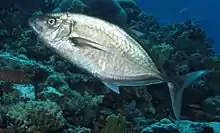 | Carangoides bajad (Forsskål, 1775) | orange-spotted trevally | Indo-Pacific, ranging from Madagascar in the west to Japan |
| Carangoides bartholomaei (G. Cuvier, 1833) | yellow jack | east coast of the Americas from Massachusetts in the north to Brazil in the south, as well as a number of offshore islands. | |
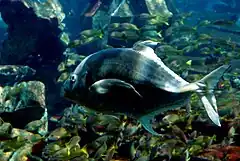 | Carangoides chrysophrys (G. Cuvier, 1833) | longnose trevally | Indian and west Pacific Oceans from South Africa to New Zealand and Japan |
| Carangoides ciliarius (Rüppell, 1830) | likely C. armatus | Massawa in the Red Sea. | |
 | Carangoides coeruleopinnatus (Rüppell, 1830) | coastal trevally | the Indian and west Pacific Oceans, from South Africa in the west to Japan and New Caledonia in the east, reaching as far south as Australia. |
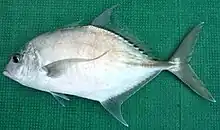 | Carangoides dinema Bleeker, 1851 | shadow trevally | the Indian and west Pacific Oceans, from South Africa in the west to Japan and Samoa in the east, reaching as far south as Indonesia and New Caledonia. |
 | Carangoides equula (Temminck & Schlegel, 1844) | whitefin trevally | e Indo-Pacific and central Pacific, ranging from South Africa in the west to Hawaii in the east. |
 | Carangoides ferdau (Forsskål, 1775) | blue trevally | Indo-Pacific and central Pacific regions, ranging from South Africa in the west to Hawaii in the east. |
 | Carangoides fulvoguttatus (Forsskål, 1775) | goldspotted trevally | western Indo-Pacific region, from South Africa in the west to Japan and Australia in the east. |
| Carangoides gymnostethus (G. Cuvier, 1833) | bludger | Indo-west Pacific Ocean, distributed from South Africa in the west to Japan and New Caledonia in the east. | |
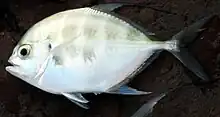 | Carangoides hedlandensis (Whitley, 1934) | bumpnose trevally | the Indo-west Pacific region, ranging from South Africa in the west to Japan and Samoa in the east. |
| Carangoides humerosus (McCulloch, 1915) | duskyshoulder trevally | eastern Indian and western Pacific Oceans, ranging from eastern India to northern Australia and Taiwan. | |
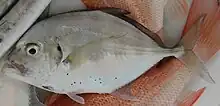 | Carangoides malabaricus (Bloch & Schneider, 1801) | Malabar trevally | Indian and west Pacific Oceans from South Africa in the west to Japan and Australia |
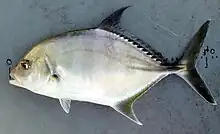 | Carangoides oblongus (G. Cuvier, 1833) | coachwhip trevally | Indo-west Pacific region, ranging from South Africa in the west to Fiji and Japan in the east |
 | Carangoides orthogrammus (D. S. Jordan & C. H. Gilbert, 1882) | island trevally | Indian and Pacific Oceans, ranging from Mozambique and the Seychelles in the west to Hawaii and the Revillagigedo Islands in the central and eastern Pacific |
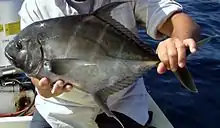 | Carangoides otrynter (D. S. Jordan & C. H. Gilbert, 1883) | threadfin jack | eastern Pacific Ocean from Baja California in the north to Ecuador and the Galapagos Islands in the south. |
_(33903457128).jpg.webp) | Carangoides plagiotaenia Bleeker, 1857 | barcheek trevally | the Indo-west Pacific region, ranging from South Africa in the west to Japan, Australia and a number of small central Pacific islands in the east. |
| Carangoides praeustus (Anonymous [ E. T. Bennett ], 1830) | brownback trevally | the Indo-west Pacific region, ranging from the Persian Gulf east to India, South East Asia and the Indonesian islands. | |
 | Carangoides talamparoides Bleeker, 1852 | imposter trevally | Indian and west Pacific oceans, from the Gulf of Oman in the west to Japan and Australia in the east |
Description
In their general morphology, the species of Carangoides are very similar to a number of other carangid genera, especially Caranx. They grow to a range of sizes, most attaining a length less than 50 cm (20 in), but with the largest fish of the genus reaching at least 1 m and over 65 kg in weight.[7] They have a relatively deep, compressed body, with the dorsal profile usually far more convex than the ventral, with a tapering posterior. The dorsal fin is in two parts, the first consisting of spines, and the second of one or two spines followed by a number of soft rays. The anal fin has detached spines preceding a long soft ray section headed by up to two spines. The caudal fin is large and forked and the pectoral fin is large, usually longer than the head. All species have scutes on the posterior section of their lateral lines.[7]
The genus is defined as having gill rakers of normal length and shape, with a total number of gill rakers between 21 and 37 on the first gill arch. Both upper and lower jaws have a band of teeth present and the breast is naked ventrally to completely scaled.[4][7]
The species are often dull in coloration, mostly being silver, getting darker dorsally and lighter ventrally. Often, they have green or blue tinges to their bodies, but fade rapidly after death. A few, such as the orange-spotted trevally, have far more brilliant coloration, incorporating bright orange and yellow spotting. The fins are usually hyaline to grey, and occasionally blue or yellow.[8]
Distribution and habitat
The Carangoides species are distributed throughout the tropical and subtropical oceans of the world, occupying the Pacific, Indian, and Atlantic Oceans. They occur on the coastlines of countries in this range, although are most prolific in the Indo-Pacific region, having high species densities around Southeast Asia, Indonesia, and northern Australia.[5]
Most species are coastal in nature, inhabiting continental shelf marine environments including reefs, bays, sandflats, lagoons, and even estuaries.[7]
Biology and fisheries

The Carangoides species are mostly schooling in nature, becoming more solitary with age. They are all predatory, taking a variety of fish, cephalopods, and crustaceans.[7] Like all of the Carangidae, they are oviparous, do not guard their eggs, and (if known) display differing reproductive traits and timing between species.[5]
All of the species are of minor to significant importance to fisheries, with some also being of interest to recreational fishermen. Like all jacks and trevallies, they can be caught on a variety of baits and lures, and with some members reaching 1 m in length, are considered formidable game fish.[9] They are generally considered to be excellent to fair table fare,[10] although a number of ciguatera poisonings have been linked to the species of this genus. As with all tropical fish, consuming smaller fish carries a lesser risk of being affected by the disease, with larger fish having accumulated more of the toxin.[11]
References
- J. S. Nelson; T. C. Grande; M. V. H. Wilson (2016). Fishes of the World (5th ed.). Wiley. pp. 380–387. ISBN 978-1-118-34233-6.
- Reed, David L.; Carpenter, Kent E.; deGravelle, Martin J. (2002). "Molecular systematics of the Jacks (Perciformes: Carangidae) based on mitochondrial cytochrome b sequences using parsimony, likelihood, and Bayesian approaches". Molecular Phylogenetics and Evolution. USA: Elsevier Science. 23 (3): 513–524. doi:10.1016/S1055-7903(02)00036-2. PMID 12099802.
- Zhu, Shi-Hua; Wen-Juan Zing; Ji-Xing Zou; Yin-Chung Yang; Xi-Quan Shen (2007). "Molecular phylogenetic relationship of Carangidae based on the sequences of complete mitochondrial cytochrome b gene". Acta Zoologica Sinica. 53 (4): 641–650. Retrieved 2008-01-03.
- Lin, Pai-Lei; Shao, Kwang-Tsao (2 April 1999). "A Review of the Carangid Fishes (Family Carangidae) From Taiwan with Descriptions of Four New Records". Zoological Studies. 38 (1): 33–68.
- Froese, Rainer and Pauly, Daniel, eds. (2008). Species of Carangoides in FishBase. June 2008 version.
- Froese, Rainer and Pauly, Daniel, eds. (2013). Species of Carangoides in FishBase. February 2013 version.
- Carpenter, Kent E.; Volker H. Niem, eds. (2001). FAO species identification guide for fishery purposes. The living marine resources of the Western Central Pacific. Volume 5. Bony fishes part 3 (Menidae to Pomacentridae) (PDF). Rome: FAO. p. 2684. ISBN 92-5-104587-9.
- Randall, John Ernest; Roger C. Steene; Gerald R. Allen (1997). Fishes of the Great Barrier Reef and Coral Sea. University of Hawaii Press. p. 155. ISBN 0-8248-1895-4.
- Starling, S. (1988). The Australian Fishing Book. Hong Kong: Bacragas Pty. Ltd. p. 488. ISBN 0-7301-0141-X.
- Davidson, Alan (2004). Seafood of South-East Asia: A Comprehensive Guide with Recipes. Ten Speed Press. p. 59. ISBN 1-58008-452-4.
- Miller, Donald M. (1990). Ciguatera Seafood Toxins. CRC Press. pp. 8–9. ISBN 0-8493-6073-0.